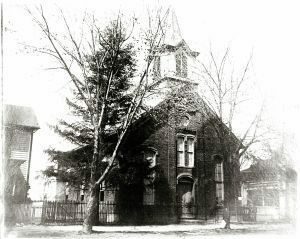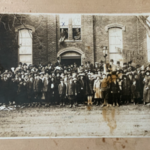A Living Legacy Since 1775
Insert your content. Try to limit your content to a maximum of 2 - 3 sentences so that you don’t lose your readers interest. A great way to break up large amounts of text is to create additional blocks.
Our Roots
-
Our congregation dates back to 1775, making us one of the oldest Methodist churches west of the Blue Ridge.
-
Early preachers like John Hagerty and Richard Owens introduced Methodism to our town, hosted by Mrs. Stephens herself.
-
Officially organized before Methodism’s split from the Church of England in 1784.
Early Worship & Growth
-
A log meeting house was constructed in 1789, followed by a brick church in 1827.
-
The first buildings had gender-separated seating and were lit by horn, candlelight, and later, oil lamps.
-
Bishop Francis Asbury visited the congregation multiple times, calling our chapel “beautiful” and “spacious.”
Historic Timeline Highlights
-
1788–1789: Log church built on Main Street.
-
1827: Brick church built with galleries and a high pulpit.
-
1882: New brick church erected after Civil War damage.
-
1915: Present church building completed.
-
1966: Educational building added.
-
2003: Major renovation adds Orrick Chapel Fellowship Hall.
Orrick Chapel Connection
-
Formed by African-American Methodists in the 1800s.
-
Rebuilt after Civil War with the help of Robert Orrick, a formerly enslaved man and liveryman.
-
Merged with SCUMC in 1991.
-
Honored with the dedication of the Orrick Chapel Fellowship Hall in 2003.
Legacy Items You Can Still See Today
-
1886 McShane Bell now stands proudly in our welcome area.
-
Pulpit furniture from 1827 and 1882 preserved.
-
Graveyard from the original log church (1809–1906) still exists.
Modern Additions
-
2003 expansion included:
-
Fully accessible 19,000 sq ft education wing
-
Future expansion-ready structure
-
Designated space for Christian formation and fellowship
-
Illuminated Belfry Project (2019)
-
Vision of Bobby Cook, a long-time church leader
-
Now a nightly symbol of hope in our town
-
Funded by members, dedicated in his honor before his passing in 2020
Why It Matters Our history is more than a timeline—it’s a testimony of faith in action. From pioneers and preachers to teachers and trailblazers, Stephens City UMC has been a spiritual home for generations. We celebrate this heritage as a foundation for our future ministry.
“Do all the good you can, by all the means you can...” – John Wesley
Overview
- The cemetery behind SCUMC dates back to the construction of the original log meeting house in 1789.
- Contains some of the oldest burials in Stephens City, including Revolutionary War veterans and early Methodist leaders.
- Now holds 69 recorded burials, with the last known in 1906.
- Green Hill Cemetery, chartered in 1874, became the preferred burial ground from the 1880s onward.
Notable Burials
- Rev. Elisha Phelps & wife Elizabeth (granddaughter of Jost Hite)
- John Bell Tilden, Revolutionary War veteran and preacher
- Thomas Steele (1834), believed to have supported the Revolutionary War
Preservation & Restoration Timeline
- 1940s: Overgrown with locust trees; goats used to manage overgrowth.
- 1957-58: Rev. A.W. Henton documented inscriptions with assistance from Mildred Lee Grove.
- 1966: Historian Garland Quarles reported damaged Tilden grave marker; family commissioned restoration.
- 1986-1992: Bobby Cook improved landscaping and removed overgrowth; church youth group cleaned headstones.
- 2010: 13 headstones restored by contractor Scott Haines.
- 2020: Stephens City Boy Scout Troop 15 restored Tilden family plot; footstones donated to Stone House Foundation.
Wrought Iron Fence
- Likely installed post-1882 with new church construction.
- Identified as a "Buckeye" fence from Mast, Foos & Co. (Springfield, Ohio, 1880).
- Gate design includes distinctive crest with halberds and scroll flourishes.
Cemetery Layout & Observations
- Rear depressions suggest unmarked or deteriorated graves.
- Some grave markers were wooden and lost to time.
- Soldiers from the Civil War possibly buried temporarily here.
- Church served as a hospital during the war; some soldiers exhumed post-war.
Modern Insights
- The cemetery is considered full and remains a sacred part of SCUMC's Methodist heritage.
- A 100-year-old black walnut tree and 75-year-old maple trees shade the grounds.
Adjacent Properties of Interest
- Parker-Doggett House (5283 Main): Built 1880s; tied to early church activities.
- 5279 Main: Original SCUMC property; later became a grocery store, phone exchange, now hobby shop.
- Other historic homes: 5271 (built 1910) and 5267 Main Street (1891).
Related Developments
- In 1958, Brison/Dinges house (1789) purchased and demolished for new education wing.
- 2003: New 19,000 sq ft fellowship hall named Orrick Chapel Fellowship Hall in honor of Orrick Chapel legacy.
Conclusion This historic cemetery remains a vital connection to SCUMC's spiritual and community roots. Ongoing restoration, community care, and detailed historical research continue to honor those who came before us.
Around 1775, two Methodist preachers—John Hagerty and Richard Owens—visited the home of Maj. Lewis Stephens, founder of Stephensburg. Their preaching is believed to be among the earliest Methodist sermons in the Shenandoah Valley. Inspired by their message, locals soon formed a small church.
Early Methodist gatherings were organized as “classes,” meeting in private homes for worship, teaching, and accountability. By 1778, Frederick County was part of the Berkeley Circuit, served by Rev. Edward Bailey, with preaching likely held in homes or a schoolhouse in Stephensburg.
The list of pastors below comes from Early Days and Methodism in Stephens City, Virginia (Inez Virginia Steele, 1994), as well as church archives and clergy appointment records.
2020–21 Bass Mitchell
2016–20 Robert Schoeman
2014–16 Bob Gochenour
2008–14 J. Jeffrey Butcher
2005–08 Stephanie Sault
1997–2004 G. Kirk Nave
1993–96 Billy Gene Johnson
1986–92 Waverly G. Reames
1981–85 Nolan R. Crowder
1978–80 Don Scott Lowery
1968–77 Warren L. Reaves
1963–67 W. R. Withers
1957–62 A. W. Hinton
1949–56 Charles A. York
1945–48 Earl S. Day
1941–44 Walter Smith
1937–40 Homer Welsh
1934–36 F. M. Lucas
1933 C. C. Bush
1931 E. A. Reades
1927–30 O. D. Lambert
1925–26 J. A. Johnson
1922–24 G. W. Gaither
1920–21 F. T. Ridgeway
1915–19 C. Sydenstricker
1912–14 Absalom Knox
1909–11 Charles Lynch
1905–08 William Stevens
1904 William E. Woolf
1900–03 Henry A. Brown
1896–99 John C. Thrasher
1893–95 James R. Van Horn
1889–92 Frank A. Strother
1886–88 J. H. DuLaney
1883–85 George T. Tyler
1881–82 A. A. P. Neel
1878–80 William A. Wade
1877 Adam B. Dolly
1876 William G. Eggleston
1875 William G. Eggleston – circuit divided
1873–74 William G. Eggleston – Asbury Register
1871–72 George Stevenson – Sydnor G. Ferguson
1869–70 William H. Wheelwright – George Stevenson
1868 James H. March – George E. Jefferson
1867 James H. March – David Bush
1866 James H. March – Edward Heterick
1865 John W. Wolfe – Edward Heterick
1862–64 John W. Wolfe – David Harris
1861 Alfred Buhrman – David Harris
1860 William S. Baird – F. A. Mercer
1859 William S. Baird – J. M. Littell
1858 Solomon McMullin – William Hedges
1857 Solomon McMullin – L. W. Berry
1856 Charles McElfresh – J. J. Leatherburg
1855 William Prettyman – William H. Holliday
1854 William Prettyman – Thomas E. Carson
1853 A. O. Ghenowith – James E. Armstrong
1852 Thomas McGee – John N. Hank
1851 Thomas McGee – H. B. Ridgeway
1850 David Trout – John N. Coombs
1848 James Sanks – James Turner
1847 William Wicks – Fouchee C. Tebbs
1846 A. A. Eskridge – J. H. Waugh
1845 A. A. Eskridge – Thomas Cornelius
1843–44 John W. Cronin – Edward L. Dulin
1842 W. O. Lumsden – John S. Martin
1841 R. M. Lipscomb – W. O. Lumsden
1840 R. M. Lipscomb – M. G. Hamilton
1839 Jacob Larkin – George W. Deems
1838 T. K. W. Monroe – William Evans
1837 T. K. W. Monroe – William G. Eggleston
1836 James Watts – Horace Noland
1835 James Watts – J. T. Payne
1834 J. Cleary – N. J. B. Morgan
1833 J. Howell – N. J. B. Morgan
1832 J. Howell – Joseph Rowen
1831 Francis McCartney – Joseph Rowen
1830 Francis McCartney – William Edmond
1829 Henry Furlong – Joseph Rowen – Richard Bond
1828 Edwin Smith – John A. Henning
1827 Edwin Smith – John L. Amiss
1826 William Hamilton – Charles B. Young
1825 William Hamilton – Thomas J. Dorsey
1824 James Reed – Thomas J. Dorsey
1823 James Reed – French S. Evans
1822 William Monroe – Bennett Dowler
1821 William Monroe – Jason Moore – William Hamilton
1820 Tobias Reiley – William Hamilton
1819 Tobias Reiley – Henry Smith
1817–18 Thomas Kennerly – William C. Morrison
1816 Hamilton Jefferson – R. Buckingham
1815 Richard Tidings – Ezra Grover
1814 Nathan Lodge – Thomas Kennerly
1813 Hamilton Jefferson – T.C. Thornton
1812 Beverly Waugh
1811 Eli Henkle – Stephensburg
1810 William Butler – Ezra Grover
1809 Caleb Reynolds – John G. Green
1808 Caleb Reynolds – Benedict Reynolds
1807 John Holmes – George Thomas
1806 Joseph Stone – Moses Laurance
1805 Jacob Gruber – John Richards
1804 Henry Smith – Samuel Monett
1803 Henry Smith – Jeremiah Browning
1802 James Quinn – Edward Matthews
1801 Nickolas Watters – Hamilton Jefferson
1800 Thornton Fleming – Thomas Daughaday
1799 Hamilton Jefferson
1797–98 Stephen Timmons – Abraham Andrews
1796 William Talbot – J. Cullison – J. Pitts
1795 William McLanaham – Thomas Lucas
1794 John Wynn – William McLanaham – Lastley Mathews
1793 Hardy Herbert – William McLanaham – Thomas Lyell
1792 Thomas Haymond – Richard Swift
1791 Lewis Chastain – Valentine Cook
1790 Lewis Chastain – Thomas Scott
1789 Thornton Fleming – Benjamin Brown
1788 Robert Ayers – Elijah Phelps
1787 Lastley Matthews – Jacob Lurton
1786 William Waters – William Harvey
1785 Eleazor Hathaway
1784 Richard Smith – Thomas Bowen
1783 Moses Park – Thomas Partridge
1782 No record
1781 Ignatius Pigman – Edward Morris – William Partridge
1780 Micaiah Debruler – John Hagerty – John Tunnell
1779 John Tunnell – John Hagerty
1778 Edward Bailey – Berkeley Circuit



